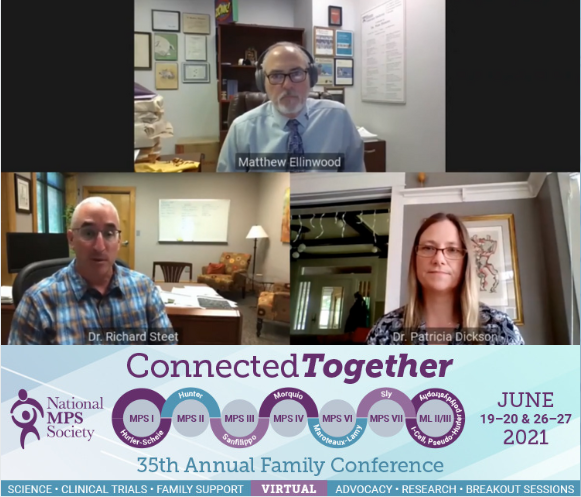

This year’s science sessions at the Society’s 35th Annual Family Conference marked the first year of a full concurrent scientific session featuring more than a dozen speakers from the United States, Australia, and Europe and a diversity of presentations. We heard from six scientists who serve on our Scientific Advisory Board (SAB); 10 speakers were past, current, or new recipients of Society Innovative Research Grants. Critical for continued research progress is the fact that a third of the presentations were delivered by early stage investigators, thus featuring and encouraging a new generation of scientists and clinicians whose work will continue to improve the outlook for patients and families in the MPS and ML community. Following are abstracts of the six scientific sessions presented at the conference. Most sessions are available to watch via YouTube, with several exceptions for presentations including unpublished data.
Among the systemic signs of ML II that have the largest clinical impact is heart disease. The exact process that drives heart disease in ML II remains unclear. Dr. Heather Flanagan-Steet of the Greenwood Genetic Center, Greenwood, SC, discussed aspects of basic heart pathology in the zebrafish model and presented results of a proof-of-principle therapy study.
Dr. Allison Bradbury of Nationwide Children’s Hospital, Columbus, OH, presented on the pathology of the ML II feline model with an update on an AAV gene therapy study in this model. Both Drs. Bradbury and Flanagan-Steet have received Society research funding; Dr. Bradbury serves on the Society’s SAB.
The theme of this session was inflammation across multiple MPS syndromes, and how a drug therapy could help as a primary or adjunct therapy in both brain and bone disease. Dr. Calogera (Lilla) Simonaro from Mt. Sinai Medical School, NY, provided an excellent overview of an area of study that she pioneered, namely the use of pentosan polysulfate (PPS) in MPS treatment. A former Society research grant recipient and current Society SAB member, Dr. Simonaro’s presentation was a comprehensive review of model studies on inflammation in MPS and pre-clinical and clinical trial work with PPS.
Dr. Jodi Smith from Iowa State University, Ames, IA, presented on Society funded research using PPS in the canine MPS IIIB model, with the possibility of evaluating this as an adjunct to gene therapy. Building on Dr. Simonaro’s work, Dr. Smith has demonstrated positive effects in the central nervous system stemming from systemic delivery of PPS as a standalone therapeutic in the MPS IIIB dog model.
Despite available transplant and enzyme therapies for MPS disorders, improvements are still much needed in the delivery and monitoring of therapy. One possible improvement is in utero initiation of enzyme replacement therapy (ERT). Dr. Tippi MacKenzie from the University of California San Francisco discussed a clinical trial for in utero ERT in MPS I, II, IVA, VI, and VII, and its potential impact on disease and anti-ERT immune response. There also is a special need for reliable predictors of cognitive disease decline and improvement in neuropathology in MPS syndromes. Dr. Troy Lund from the University of Minneapolis presented exciting results for MPS I which could improve therapy development by validating biomarkers of disease. Dr. Lund’s presentation included work done with SAB member Dr. Julie Eisengart as part of a grant from the Orphan Disease Center.
With therapy available for MPS II, and a potential for MPS II to be approved for newborn screening on the horizon, there is a pending need to better understand the early neuropathic disease in MPS II. Dr. Enrico Moro from the University of Padua in Italy presented his Society-funded research of the developmental changes in the zebrafish MPS II brain. He discussed the potential implications he discovered on MPS II brain disease in children. Dr. Igor Nestrasil, from the University of Minnesota, a past recipient of Society research funding, provided an excellent comprehensive overview of MPS II and discussed MRI approaches to imaging the brain that could help better understand and predict cognitive disease in the MPS II patient.
Continuing with the theme of MPS II research, this session focused on the importance of predicting disease severity in MPS II. Newborn screening necessitates early predictions of disease severity. Most early diagnoses involve mutation studies, but sometimes these results are of limited use in predicting disease severity, especially in MPS II. In two recent Society funded research projects, Dr. Patti Dickson from Washington University, St. Louis, and Dr. Richard Steet from the Greenwood Genetic Center (both members of the Society’s SAB) presented on the different and complementary approaches they are taking to investigating this problem in MPS II.
The last science program session involved overviews of broad themes important in MPS disease, with an extended question and answer period with presenters SAB Chair Dr. Lynda Polgreen and Dr. Michelina Iacovino, both of the Lundquist Research Institute in Torrance, CA, and SAB Associate Chair Dr. Kim Hemsley of Flinders University, Australia. Drs. Polgreen and Iacovino discussed immune system-based disease and dysfunction in MPS and its implications on disease and treatment. There is exciting new data indicating that MPS may have an autoimmune component to the disease process. Dr. Hemsley provided an excellent overview of the common aspects of brain disease in MPS, detailing what we have learned from basic and model research over the years.